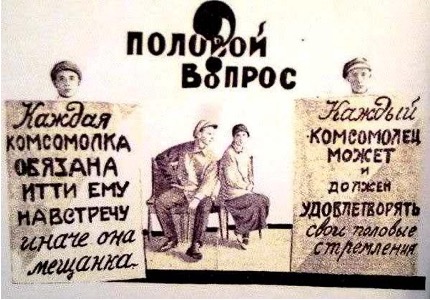The construction of the communist state was accompanied by a political program to solve the so-called “women's issue” and the formation of a new Soviet femininity. The concept of forming a new woman was represented by several gender policies and political campaigns designed to turn her into a Soviet – citizen, worker and mother. One such gender policy that was significant and striking for its time was the Bolshevik resolution “On the artificial termination of pregnancy”. The legalization of abortion, it would seem, can be interpreted as an important step in the policy of women's emancipation. However, the texts and policies of the Bolshevik ideologists of that time constantly emphasized that this law was a forced measure due to the increase in the number of criminal abortions during the post-war devastation, changes in the social system and anomie. The abortion policy, in its various forms, was always a byproduct of pronatalist concern about the nation’s demographic consequences. The Soviet leaders proclaimed motherhood as a social obligation and to uphold this proclamation they developed policies, programs and services to discourage abortion and encourage motherhood[1].
During the Russian Empire, abortion was a crime. Criminal punishment was envisaged both for the person who performed the abortion and for the pregnant woman herself. After the coup organized by the Bolsheviks in the fall of 1917, later called the “Great October Socialist Revolution”, the country rapidly got on the new Bolshevik rails. Following the October Revolution, as the Bolsheviks cast aside the remnants of the “old world”, the attitudes towards family, sex, and gender that were associated with the “bourgeoisie” received increased attention and became the subject of critical examination.
First, the 1919 Family Law weakened the institution of marriage and crippled the structure and function of the family. Notably, it introduced groundbreaking concepts such as no-fault divorce and civil marriage recognition, revolutionizing the dissolution of marriages and challenging the traditional religious significance of matrimony. Additionally, the law fervently advocated for gender equality, empowering women with equal rights within the marital bond and reshaping familial dynamics by defying societal norms and hierarchies. Second, sexual permissiveness was propagated, as evidenced by the Bolshevik posters of the 1920s (Figure 1)[2] – “Every Komsomol (male) can and must satisfy his sexual aspirations”, “Each Komsomol (female) is obliged to meet him halfway, otherwise she is a petty bourgeois”. Then, against the backdrop of an ideological struggle against “bourgeois remnants” the People’s Commissariats of Health and Justice jointly adopted resolutions “On the artificial termination of pregnancy”, making the Soviet Union the first country in which a woman could legally have an abortion[3].




